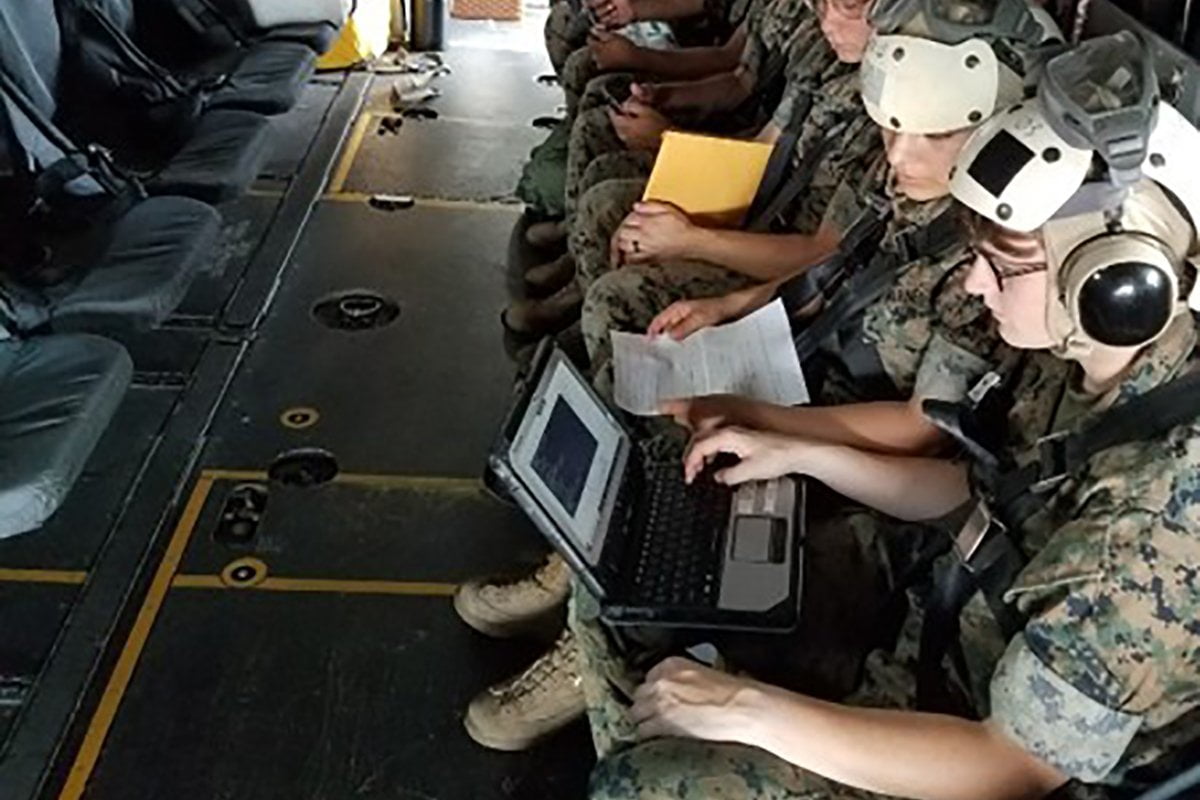By Robbin Laird
In a series of articles based on interviews with the USMC, the nature and scope of the digital interoperability initiative being pursued by Marine Corps Aviation has been highlighted.
In one of those articles, the discussion highlighted a way ahead with regard to digital interoperability for the insertion force.
Because the team needs to work with a wide range of aircraft, each of which has its own dynamic of upgradeability, the approach being taken to connectivity is to have an upgrade path across the fleet but not tied to any particular platform.
Hence, the logic of separating platform upgradeability from C2 connectivity upgradability but finding ways to cross link such dynamic developments.
In shaping the way ahead, the Marines have identified what they believe to be the four key pillars for each interoperable platform.
Those four key pillars are relevant sensors, processors on board to process data to be part of the C2 loop, interfaces which allow for interacting with network generated data and information, and network radios which are normally designed for specific environments whether air-to-air, air-to-ground or ground-to-ground.
This four-pillar template is how the Marines hope to be able to address any innovations to be woven into the DI architecture.
The four pillars are really about configuration management and understanding the essential elements to consider for DI.
As the DI foundation is shaped and executed, moving forward with software upgradeability in the C2 hubs will allow for innovations going forward.
The strategic goal of the MANGL approach is to step out of the platform approach and look at the MAGTF as a whole.
In my view, what the Marines are doing is shaping a template to move forward, which is not a final statement of where they are but rather a trajectory of change.
The Marines are shaping an approach which allows them to have ownership of their digital infrastructure and leverage contractors as partners in shaping code evolution for various pieces in the software upgradeable systems working together to deliver DI.
The Marines are bridging stove piped systems which have been built for tailored tasks or missions.
With the coming of new software defined systems, there is a growing capability to think beyond task-oriented networks and towards cross cutting integratability.
The goal is to use existing radios and find ways to work these existing capabilities to work more effectively together, rather than laying down a new integrated approach and then buying new C2 sets to execute a new integratable approach.
Since that conversation with the USMC Aviation Headquarters’ digital interoperability team, I have had a chance to discuss the challenge of integratability with the Air Warfare Center at Nellis, at NAWDC at Fallon and with Marines at MAWTS-1.
In those discussions, a clear contribution which the Marines can make and are expected to make in the Pacific, as well as globally, is to provide for mobile basing, including forward expeditionary bases, for the joint and coalition force.
It is clear from my discussions at MAWTS-1, that this capability certainly seen from a kill web perspective, requires very effective C2/ISR wave form integratability which takes us back to the central significance of the digital interoperability initiative for this core function of the USMC going forward.
In other words, investments in an effective digital interoperability approach are not simply about investments in technologies; they are investments in the enablement of the force to be able to perform a core function, mobile and expeditionary basing, effectively, notably in a contested environment.
Major Salvador Jauregui and Mr. Lowell Schweickart from the USMC Aviation Headquarters who are working on the digital interoperability effort have been my guides through the digital interoperability process and I have returned to take up this core point of the impact of DI on mobile and expeditionary basing.
The team highlighted that for mobile and expeditionary basing to work effectively going forward would require the Marines shaping enhanced skill sets to operate within the information environment.
The more distributed the force, the more such a capability becomes an essential one.
The integratability piece enabled by DI is a key one as well.
To the extent platforms can share wave forms, they can share their capabilities within the combat space, rather than having to have full up organic capabilities on any one platform.
Put another way, as one conceives of a mobile or expeditionary base which one wishes to move on the kill web chess board, a key question is what wave forms the force at that base needs to have access to in order to have mission success.
Rather than simply conceiving a platform strike package, the question is which wave forms on which platforms are crucial to engage together to achieve the particular mission?
As the team noted: “You can leverage the strengths of your neighbors to make you a stronger player within the integrated force.”
Shaping this DI-enabled expeditionary force capability is crucial in order to make effective use of coming maritime remotes or “unmanned” air systems which can be woven into such a force.
Rather than highlighting the autonomous technologies, the foundation needs to be laid for the secure and agile wave form integratable technologies which could empower the deployed force.
Put in blunt terms, investments in appropriate C2 technologies are not ends in themselves, but enablers for a distributed integratable force.
And for the USMC, this means enabling mobile and expeditionary bases which can operate across the chessboard of the extended battlespace and expanding the capabilities of the joint or coalition force.
The featured photo: Ground communications specialist Marines use the Networking On-the-Move-Airborne Increment II System on an MV-22 Osprey during a flight at Marine Corps Air Station New River, North Carolina.
In February 2019, Marine Corps Systems Command fielded the first NOTM-A Inc. II System to the 22nd Marine Expeditionary Unit to enhance their ability to communicate in the air. US Marine Corps Photo


